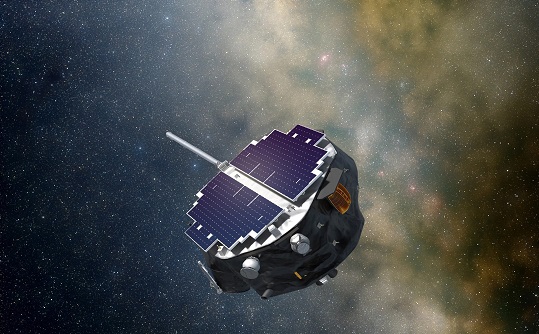Bern, Sept 08, 2025.- The University of Bern is participating in the international NASA Interstellar Mapping and Acceleration Probe mission (IMAP), which is due to be launched no earlier than 23 September 2025. IMAP is dedicated to exploring the outer limits of the heliosphere, the protective bubble of solar wind in which our solar system is located. The findings should revolutionize our understanding of interstellar space, space weather and the protective function of the heliosphere for the Earth.
NASA’s Interstellar Mapping and Acceleration Probe (IMAP) mission, led by Princeton University and managed by the Johns Hopkins Applied Physics Laboratory, is scheduled to launch from the Kennedy Space Center in Florida no earlier than 23 September 2025. It will explore the outer limits of the heliosphere. The heliosphere is the space around the sun, which is defined by the solar wind and in which all the planets in the solar system are located. The mission investigates two central questions of heliophysics: How are charged particles accelerated by the sun and how does the solar wind interact at the boundary to the interstellar environment? Among other things, these questions are crucial for understanding the dynamic processes that influence space weather and can cause potentially dangerous conditions in near-Earth space.
The Space Research and Planetary Sciences Division of the Physics Institute of the University of Bern has contributed to the development of two IMAP particle instruments, in particular to the IMAP-Lo instrument. The University of Bern contributed to the calibration and verification of the instrument with the unique MEFISTO facility and provided a novel measurement device. Prof. Dr. Peter Wurz and PD Dr. André Galli are co-investigators, and Michela Gargano is project leader for the Bernese contribution to IMAP-Lo. The lead role for the IMAP-Lo instrument lies with the University of New Hampshire (UNH). The IMAP team also includes scientists from the Southwest Research Institute (SwRI), the Johns Hopkins Applied Physics Laboratory (APL) and Princeton University. The University of Bern is one of the few European institutions contributing hardware to the IMAP mission. The funding for the contribution of the University of Bern was awarded by the European Space Agency (ESA) in the frame of the PRODEX programme (see infobox below).
Revolutionary findings about the heliosphere expected
The solar wind consists of charged particles that fly away from the sun at an average speed of around 400 kilometers per second. In the boundary layer, known as the heliopause, the solar wind meets interstellar space. Peter Wurz explains: «Life as we know it is not possible out there due to the intense cosmic radiation. The heliosphere is a kind of protective shield for us on Earth, because it keeps most of this cosmic radiation from reaching the Earth.»
IMAP aims to find out what happens at the heliopause, the outermost boundary of the heliosphere where the solar wind meets interstellar space, and provide real-time data on the solar wind and high-energy particles that can cause dangerous conditions in near-Earth space. «When the Sun is particularly active, such as during a solar storm, the solar wind can carry an enormous amount of energy, causing major disturbances in the space weather,» says Wurz. Such solar storms can damage the power grid on Earth, affect satellites, communication systems and GPS navigation, and be dangerous for astronauts and high-atmosphere air travel. «Research into space weather is therefore extremely important in our high-technology society,» emphasizes Wurz.
The IMAP probe will be positioned around 1.5 million kilometers from Earth in the direction of the sun, at the Lagrange point 1 (L1). André Galli explains: «Lagrange points are positions in space where the gravitational forces of two celestial bodies (in our case the Sun and the Earth) are in equilibrium with the centrifugal force of a smaller object (in our case the IMAP space probe). IMAP will orbit the Sun together with the Earth.» The L1 is ideal for positioning the space probe, as IMAP can detect the particle streams of the solar wind from there at an early stage before they reach the Earth and can measure particles from all directions from interstellar space. In addition, a stable radio link to Earth is possible from there for scientific data transfer. «The spatial resolution and the energy range of the particles studied by the IMAP mission promise to revolutionize our knowledge of the heliosphere and its interstellar environment,» says Galli.
Valued Bernese expertise for international space missions
On board the IMAP probe are ten scientific instruments that register particles to draw a comprehensive picture of space. At its heart are three instruments that measure particles in three different energy ranges. The University of Bern has produced the optical design for the IMAP-Lo instrument, which will measure particles in the low-energy range. «The optical design involves special surfaces that are used to ionize particles so that they can ultimately be detected in the detector,» explains Michela Gargano, a technology developed at the University of Bern. «The instrument will measure both so-called ENAs, neutral atoms in the low-energy range that are created when solar wind and interstellar medium collide, as well as interstellar neutral particles from outside the solar system,» Gargano continues.
In the laboratories of the Space Research and Planetary Sciences Division at the Physics Institute of the University of Bern, instruments or parts thereof for space missions have been developed and built in the in-house workshops for decades. Wurz says: «International space organizations such as NASA and ESA regularly rely on Bernese expertise for their missions. For example, the University of Bern was already involved in NASA’s predecessor mission to IMAP, the Interstellar Boundary Explorer (IBEX) mission.»
For the IMAP mission, the University of Bern also contributed to the calibration of the IMAP-Lo instrument with the MEFISTO facility. MEFISTO is a unique facility for the calibration of ion and neutral particle instruments. «It also enabled the Bernese team to develop a novel reference instrument for calibration, which is now in use at the Princeton university test facility,» Wurz concludes.
About the IMAP mission
The groundbreaking IMAP mission addresses several critical questions by studying the heliosphere boundary from afar. The spacecraft orbits the Sun at a location 1 million miles (1.5 million kilometers) from Earth toward the Sun, called Lagrange Point 1 (L1). Positioned at L1, IMAP can provide astronauts and spacecraft near Earth with roughly 30 minutes’ warning of incoming harmful radiation. IMAP spins once every 15 seconds, allowing the comprehensive suite of 10 instruments to scan every part of the heliosphere. The spacecraft collects near-real-time measurements of the solar wind’s high-energy particles and magnetic fields in interplanetary space and also collects, counts, and measures ENAs, which are fast-moving particles formed when charged particles from the solar wind gain or exchange electrons and become neutral, allowing them to travel without being impacted by magnetic fields. IMAP also continually monitors space weather to protect space explorers and critical space infrastructure.
The collection of data is used to create a comprehensive map of the Sun’s influence, an instrumental piece in resolving the fundamental physical processes that control our solar system’s evolving space environment and in answering the following key questions:
What are the properties of the local interstellar medium?
How does the Sun’s magnetic field interact with the local interstellar medium?
How do the solar wind and interstellar medium interact at the boundary of our heliosphere?
How do parts of the solar wind rapidly accelerate to incredible energies?
The IMAP mission’s scientific goals and objectives build on a heritage of findings from past missions that have expanded our knowledge of the heliosphere and its dynamics, dating back to NASA’s Voyager program that began in the 1970s. Since 2009, NASA’s Interstellar Boundary Explorer (IBEX) mission has imaged the entire sky, giving us a complete global view of the heliosphere’s boundary. Combined data from both Voyager and IBEX have helped scientists create a more complete model of the boundary of our solar system. New instruments aboard IMAP collect ENAs over a larger energy range and more frequently than IBEX, allowing better mapping of the heliosphere.
More information and the media kit are available for download on NASA’s official IMAP website https://science.nasa.gov/mission/imap/
Funding by the SERI / Swiss Space Office
Switzerland participates in the PRODEX program (PROgramme de Développement d’EXpériences scientifiques) of the European Space Agency ESA, which supports the development of scientific instruments for space missions or subsystems thereof. Via PRODEX, national contributions to science missions can be developed and built by project teams from research and industry. This transfer of knowledge and technology between science and industry ultimately also gives Switzerland a structural competitive advantage as a business location, and it enables technologies, processes, and products to flow into other markets thus generating added value for our economy.
Bernese space exploration: With the world’s elite since the first moon landing
When the second man, «Buzz» Aldrin, stepped out of the lunar module on 21 July 1969, the first task he did was to set up the Bernese Solar Wind Composition experiment (SWC) also known as the “solar wind sail” by planting it in the ground of the moon, even before the American flag. This experiment, which was planned, built and the results analyzed by Prof. Dr. Johannes Geiss and his team from the Physics Institute of the University of Bern, was the first great highlight in the history of Bernese space exploration.
Ever since Bernese space exploration has been among the world’s elite, and the University of Bern has been participating in space missions of the major space organizations, such as ESA, NASA, and JAXA. With CHEOPS the University of Bern shares responsibility with ESA for a whole mission. In addition, Bernese researchers are among the world leaders when it comes to models and simulations of the formation and development of planets.
The successful work of the Department of Space Research and Planetary Sciences (WP) from the Physics Institute of the University of Bern was consolidated by the foundation of a university competence center, the Center for Space and Habitability (CSH). The Swiss National Fund also awarded the University of Bern the National Center of Competence in Research (NCCR) PlanetS, which it manages together with the University of Geneva.










